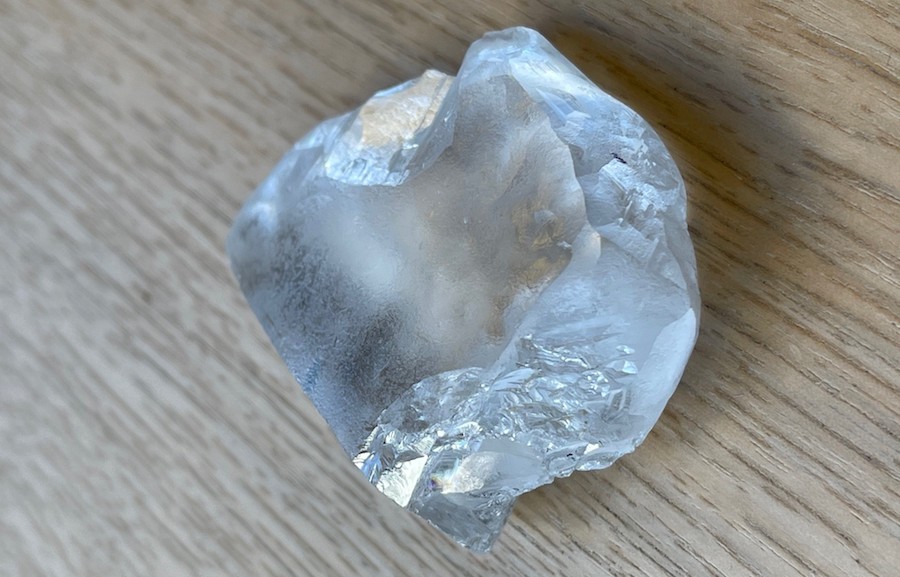A natural diamond is a gemstone composed of crystallized carbon that was formed deep within the Earth’s mantle under extreme heat and pressure over 1 to 3 billion years ago. Unlike lab-grown diamonds, which are created in controlled environments, natural diamonds are mined from the Earth and are considered one of the rarest and most valuable gemstones.
Formation of Natural Diamonds
Natural diamonds form 100–200 km (62–124 miles) below the Earth’s surface, where intense pressure (725,000+ psi) and high temperatures (1,100–1,400°C) cause carbon atoms to bond in a unique cubic crystal structure. These diamonds are then transported to the surface through volcanic eruptions, specifically via kimberlite pipes—ancient volcanic conduits that carry rough diamonds upward.
Characteristics of Natural Diamonds
Composition:
Made of pure carbon arranged in a tetrahedral lattice, giving diamonds their exceptional hardness.
Hardness (Mohs Scale 10):
The hardest known natural material, making it highly resistant to scratches and wear.
Brilliance & Fire:
Due to its high refractive index (2.42), a well-cut diamond reflects and disperses light, creating its signature sparkle.
Unique Inclusions & Imperfections:
Most natural diamonds contain inclusions (internal characteristics) and blemishes (surface characteristics) that serve as fingerprints of their natural origin.
Rarity & Value:
Large, flawless natural diamonds are exceptionally rare, making them highly valuable compared to lab-grown alternatives.
Types of Natural Diamonds
1. White (Colorless) Diamonds
The most sought-after diamonds, graded on a color scale from D (colorless) to Z (light yellow or brown).
The less color, the higher the value.
2. Fancy Color Diamonds
Natural diamonds can exhibit blue, pink, yellow, green, orange, and even red hues due to trace elements or structural irregularities.
Examples:
Blue diamonds (trace boron) – Example: The Hope Diamond
Pink diamonds (structural distortions) – Example: Argyle Pink Diamonds
Yellow diamonds (trace nitrogen) – Example: Tiffany Yellow Diamond
3. Industrial Diamonds
Low-quality natural diamonds used in cutting, drilling, grinding, and polishing tools due to their extreme hardness.
How Natural Diamonds Are Mined
Natural diamonds are extracted from the Earth using various mining techniques:
Kimberlite Pipe Mining (Primary Source)
Diamonds are found in kimberlite pipes, ancient volcanic conduits rich in diamond-bearing rock.
Mined using open-pit or underground methods.
Alluvial Mining (Secondary Source)
Diamonds eroded from kimberlite pipes are transported by rivers and accumulate in riverbeds or coastal areas.
Marine Mining
Specialized ships mine diamonds from the ocean floor, particularly off the coast of Namibia and South Africa.
How Natural Diamonds Are Identified
To distinguish a natural diamond from a lab-grown or synthetic diamond, experts use advanced testing and certification from recognized gemological labs like DCLA, GIA, and AGS.
Key Identification Methods:
Inclusions & Growth Patterns: Natural diamonds contain unique inclusions, such as tiny crystals, feathers, or graining patterns, absent in lab-grown diamonds.
Fluorescence & Phosphorescence: Some natural diamonds exhibit fluorescence under UV light, while lab-grown diamonds may show different reactions.
Spectroscopy & Advanced Testing: High-tech tools like FTIR (Fourier-transform infrared spectroscopy) and UV-Vis spectrometry help differentiate natural diamonds from synthetic or treated ones.
Natural Diamonds vs. Lab-Grown Diamonds
Feature Natural Diamond Lab-Grown Diamond
Formation Formed over billions of years in Earth’s mantle Created in weeks using HPHT or CVD methods
Origin Mined from the Earth Manufactured in a lab
Inclusions Natural growth patterns and inclusions Different internal characteristics, sometimes with metallic inclusions (HPHT)
Rarity Extremely rare, especially high-quality stones Mass-produced
Price Higher due to rarity Generally 50–70% cheaper
Resale Value Strong resale and investment value Limited resale market
Ethical Concerns Some concerns over ethical sourcing (unless from certified conflict-free sources) Considered conflict-free and more sustainable
Ethical & Sustainable Sourcing of Natural Diamonds
Concerns over “blood diamonds” (conflict diamonds) led to the Kimberley Process Certification Scheme (KPCS), which ensures that natural diamonds are ethically sourced and do not fund conflicts.
Reputable diamond companies, including DCLA-certified brands, focus on:
Conflict-free mining practices
Fair labor policies
Sustainable environmental impact reduction
Why Choose a Natural Diamond?
Timeless Value: Unlike lab-grown diamonds, natural diamonds retain strong resale and investment value.
Unique & One-of-a-Kind: Each natural diamond has its own history, inclusions, and growth patterns, making it a unique creation of nature.
Symbolism & Tradition: Used in engagement rings, heirlooms, and high jewelry, natural diamonds carry deep emotional and historical significance.
